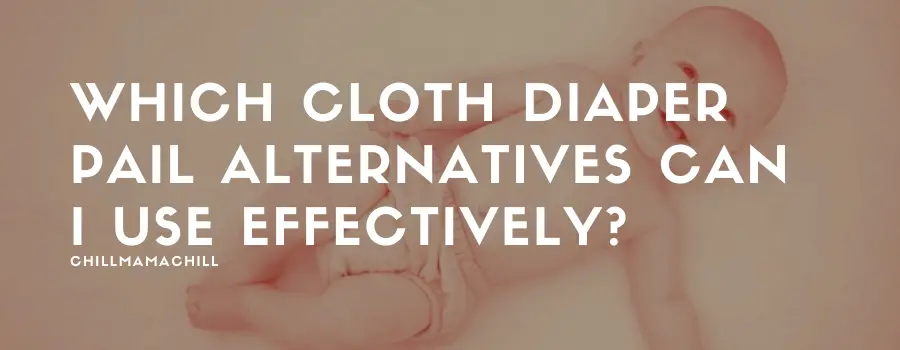Are you planning to use or have been using cloth diapers instead of disposables? Overall hygiene, a less complicated changing routine, and odor containment make pails a non-negotiable part of your nursery. But are there cloth diaper pail alternatives that are effective, less expensive, and have a large enough mouth for storing soiled nappies between washes?
There are alternatives to cloth diaper pails that can replace costly disposable nappy solutions with additional odor combatants. You can also escape the never-ending cycle of pail bags or refills while leveraging common place improvisations. A fabric nappy storage alternative will consist of a lidded receptacle or air-tight bag that sufficiently contains odors.
A cloth diaper pail alternative lets you place dirty diapers in odor and germ-free conditions until you’re free to wash them. In the following article, I will explain your options for nappy storage alongside suggestions for eliminating odors.
What Alternatives Can I Use Instead of Commercially Available Cloth Diaper Pails?
Dirty diapers are an aspect of motherhood that nobody looks forward to. The wetness, soiling, and smell are more pronounced if you’ve decided to go with cloth diapering, not to mention the unseen germs. Besides commercial diaper pails, their alternatives offer containment and odor elimination solutions at a fraction of the costs.
The diaper pails available at baby isles all over also don’t work well with cloth diapers, mainly due to their design. Since most completely seal diapers in bags or refills, they promote mold and bacterial growth on your nappies.

Many pails and genies have minimized receptacles or mouths as a means of containing smells. That proves cumbersome when you’re dumping in cloth diapers. You have three options for diaper storage, determined by the amount of space available and how often you plan to do laundry. These include;
- Dry cloth diaper pail
- Wet cloth diaper pail
- Combination cloth diaper pail
The Dry Pail Alternative
As the most common method of cloth diaper storage, the dry pail contains dry or non- presoaked diapers using waterproof reusable bags. You can use a lidded and lined trash can or plastic pail or hang the bag on a doorknob or hook. With this method, you need to find an effective odor eliminator alongside the alternative pail setup.
If you use dry pails, remember to remove any solid soiling from your child’s cloth diaper before popping it into the non-porous bag. On wash day, it’s easy to load dry pail contents into the front or top-loading machines.
If you’re using a garbage can or plastic bucket, the best liner is the type with elastic snugs around the edge. These ensure that your bag doesn’t slip when you throw in diapers, common in regular trashcans. Use two liners; the inner goes into the wash with your diaper load, while the outer remains ready to receive more weighty packages.
The Wet Pail Alternative
Your diaper pail, in this instance, contains a minimal amount of water to presoak and reduce odors. Other additives that can be added include baking powder, vinegar, washing soda, essential oils, borax whitener, or other baby-safe stain removers.
To contain smells and counter the stains, you must change the water you’ve not washed your cloth diapers every day. While not recommended for most cloth diapers today, wet pail alternatives work best with a top-loading washing machine.
Avoid detergents or chlorine bleach which can cause chemical reactions with your child’s urine. These are also harsh on fabrics, voiding manufacturer warranties. A wet cloth diaper pail can pose a drowning risk to toddlers and small pets, so get a tight-lidded container.
Dry and Wet Pail Combination
You can use both wet and dry alternative pails for cloth diaper storage by using inserts. When your baby has soiled diapers, remove the insert and rinse using a pail with water. The dry shell then goes into the non-presoak container.
The combination method works best to preserve your nappies since regular soaking in water can be rough on the fabric. However, keep an eye out for mold in your dry pail, or schedule more frequent washes for the cloth diaper shells.
What Are the Best Cloth Diaper Pail Alternatives?
Since you’ve chosen to go with cloth diapers, you must select a pail alternative that keeps clean and fresh smelling. The best commercial pails and genies substitute that you can effectively include;
A Common Garbage Can
Cost-wise, you’re slashing the price of commercial diaper pails by more than half when you use an ordinary trashcan.

You can store wet cloth diapers directly into this pail alternative by the soiled ones will require trying into a non-porous plastic bag to contain odors. A garbage can with a steel or plastic lid is sizeable enough for a half weekly wash schedule while being durable.
Dog Poop Bags
These non-expensive canine litter bags act as excellent cloth diaper pail alternatives. While they’ll prevent leakages, the specially designed bags are scented to deal with poop odors. They are easy to unroll, germ-free, and can work well combined with a trash can pail.
Grocery Bags
You’ve got a pile of used grocery bags from your local store. You can fashion these into cheap cloth diaper pail alternatives. Tie up your dry or presoaked diapers with a plastic bag and hang them behind a door or on a hook. These makeshift pails will cost nothing, but you’ll need to use an odor minimizer but don’t wait too long before washing nappies.
Waterproof Wet Bags
Wet bags are traditionally used to carry toiletries or bathing suits, but you can use these reasonably priced items as cloth diaper pail alternatives. As an eco-friendly option, the zippered bag works better to contain orders than a grocery bag. They’re available in different sizes, shapes, and designs, are leak-proof and washable.
Conclusion
Besides vinegar and baking soda as odor combatants that work alongside your cloth diaper pail alternative, you can use carbon filters or activated charcoal purifying bags. A deodorizer, essential oils, or inserts that you pop into a wet pail also reduces smells.
Consider a sizeable cloth diaper pail alternative to save you at least two soiling days before laundry if you have twins or multiples. Allow a little circulating air in your dry pail storage for cloth diapers. Don’t seal the lid too tightly in order to kill bacteria that cause odors, strangely.

I’m Cathrine and I’m a 39-year-old mother of 3 from Utica, New York. And I’m extremely happy you’ve come to visit my hide-out on the web. Here I post about everything related to family-life and usually it will involve babies and lessons I’ve learned over the years from experts, friends, and my own mistakes. So hopefully you will find what i write fun and informational!


